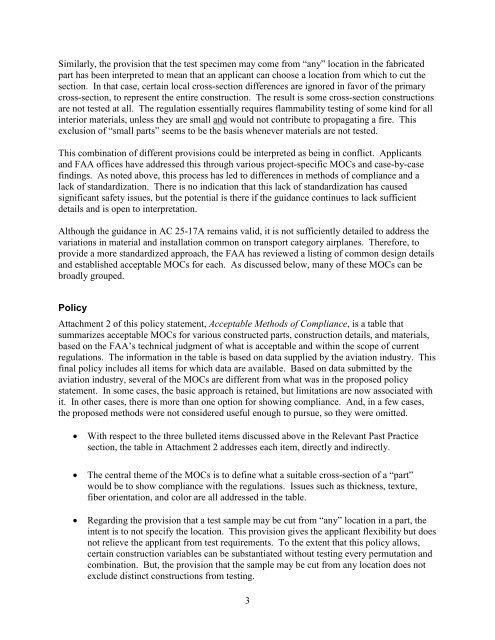Policy Statement on Flammability Testing of Interior Materials Final
Policy Statement on Flammability Testing of Interior Materials Final
Policy Statement on Flammability Testing of Interior Materials Final
Create successful ePaper yourself
Turn your PDF publications into a flip-book with our unique Google optimized e-Paper software.
Similarly, the provisi<strong>on</strong> that the test specimen may come from “any” locati<strong>on</strong> in the fabricated<br />
part has been interpreted to mean that an applicant can choose a locati<strong>on</strong> from which to cut the<br />
secti<strong>on</strong>. In that case, certain local cross-secti<strong>on</strong> differences are ignored in favor <strong>of</strong> the primary<br />
cross-secti<strong>on</strong>, to represent the entire c<strong>on</strong>structi<strong>on</strong>. The result is some cross-secti<strong>on</strong> c<strong>on</strong>structi<strong>on</strong>s<br />
are not tested at all. The regulati<strong>on</strong> essentially requires flammability testing <strong>of</strong> some kind for all<br />
interior materials, unless they are small and would not c<strong>on</strong>tribute to propagating a fire. This<br />
exclusi<strong>on</strong> <strong>of</strong> “small parts” seems to be the basis whenever materials are not tested.<br />
This combinati<strong>on</strong> <strong>of</strong> different provisi<strong>on</strong>s could be interpreted as being in c<strong>on</strong>flict. Applicants<br />
and FAA <strong>of</strong>fices have addressed this through various project-specific MOCs and case-by-case<br />
findings. As noted above, this process has led to differences in methods <strong>of</strong> compliance and a<br />
lack <strong>of</strong> standardizati<strong>on</strong>. There is no indicati<strong>on</strong> that this lack <strong>of</strong> standardizati<strong>on</strong> has caused<br />
significant safety issues, but the potential is there if the guidance c<strong>on</strong>tinues to lack sufficient<br />
details and is open to interpretati<strong>on</strong>.<br />
Although the guidance in AC 25-17A remains valid, it is not sufficiently detailed to address the<br />
variati<strong>on</strong>s in material and installati<strong>on</strong> comm<strong>on</strong> <strong>on</strong> transport category airplanes. Therefore, to<br />
provide a more standardized approach, the FAA has reviewed a listing <strong>of</strong> comm<strong>on</strong> design details<br />
and established acceptable MOCs for each. As discussed below, many <strong>of</strong> these MOCs can be<br />
broadly grouped.<br />
<str<strong>on</strong>g>Policy</str<strong>on</strong>g><br />
Attachment 2 <strong>of</strong> this policy statement, Acceptable Methods <strong>of</strong> Compliance, is a table that<br />
summarizes acceptable MOCs for various c<strong>on</strong>structed parts, c<strong>on</strong>structi<strong>on</strong> details, and materials,<br />
based <strong>on</strong> the FAA’s technical judgment <strong>of</strong> what is acceptable and within the scope <strong>of</strong> current<br />
regulati<strong>on</strong>s. The informati<strong>on</strong> in the table is based <strong>on</strong> data supplied by the aviati<strong>on</strong> industry. This<br />
final policy includes all items for which data are available. Based <strong>on</strong> data submitted by the<br />
aviati<strong>on</strong> industry, several <strong>of</strong> the MOCs are different from what was in the proposed policy<br />
statement. In some cases, the basic approach is retained, but limitati<strong>on</strong>s are now associated with<br />
it. In other cases, there is more than <strong>on</strong>e opti<strong>on</strong> for showing compliance. And, in a few cases,<br />
the proposed methods were not c<strong>on</strong>sidered useful enough to pursue, so they were omitted.<br />
• With respect to the three bulleted items discussed above in the Relevant Past Practice<br />
secti<strong>on</strong>, the table in Attachment 2 addresses each item, directly and indirectly.<br />
• The central theme <strong>of</strong> the MOCs is to define what a suitable cross-secti<strong>on</strong> <strong>of</strong> a “part”<br />
would be to show compliance with the regulati<strong>on</strong>s. Issues such as thickness, texture,<br />
fiber orientati<strong>on</strong>, and color are all addressed in the table.<br />
• Regarding the provisi<strong>on</strong> that a test sample may be cut from “any” locati<strong>on</strong> in a part, the<br />
intent is to not specify the locati<strong>on</strong>. This provisi<strong>on</strong> gives the applicant flexibility but does<br />
not relieve the applicant from test requirements. To the extent that this policy allows,<br />
certain c<strong>on</strong>structi<strong>on</strong> variables can be substantiated without testing every permutati<strong>on</strong> and<br />
combinati<strong>on</strong>. But, the provisi<strong>on</strong> that the sample may be cut from any locati<strong>on</strong> does not<br />
exclude distinct c<strong>on</strong>structi<strong>on</strong>s from testing.<br />
3
















